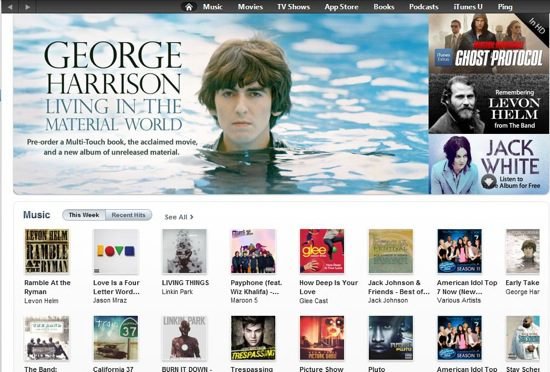By Heather Snavely
When you think of album promotion, there are two ends of the scale. At one end – where most bands live – is a van driving from club to club and merchandise ready to sell at the end of each show. At the other end is the iTunes marketplace takeover where the likes of Jack White and Of Monsters and Men are able to promote pre-sales, new tracks and full albums.
“Blunderbuss” – Jack White from Blunderbuss
“Lakehouse” – Of Monsters and Men from My Head Is an Animal
Record Store Day reminds us of the place in-between those two worlds – where indie record stores still remain, in-store performances are held, store window fronts are transformed, and, in some places, were external facades become canvases for life-sized album cover art.
At the heart of Record Store Day is the celebration the “art of music,” and for the indie record store of yore, there was no greater art than the album mural. Yet, like every aspect of the music industry over the years, technology has changed just about everything. But it wasn’t iTunes and the Internet that killed the mural; music murals went the way of vinyl as computers and printing presses made it possible to churn out giant, weather-resistant posters.

But just as vinyl is upheld as the purest way to listen to music, in a few places around the country, the album mural is considered the purest way to market music. One such place is Seattle, where record stores like Easy Street and Silver Platters offer up their exterior walls to artistic recreations of albums covers by Pearl Jam, The Lumineers, and even Lana Del Rey.
Glenn Case is the man behind the paint brush in Seattle. He believes murals are flourishing globally, “but as far as record stores utilizing the talents of a mural artist goes, I know of very few. As the profit margins in the music industry have shrunk in this MP3 era, stores and record labels have relied on sign companies to pump out vinyl billboards and banners to get their messages across.”
Fortunately, Case doesn’t think all is lost; he theorizes that, as more people return to vinyl, album artwork will regain some significance.
“I do believe that as people are re-discovering vinyl at their local stores, the artwork is regaining some significance as the proportions of the record sleeve square are very flattering for the presentation of the album’s artwork. [It’s] something to draw the eye and reflect the tone of that particular music, and sell, of course.”
“Sell” is the key word there. Why do some indie record stores – already squeezed by smaller margins – still invest in something so costly? Matt Vaughn, president of Easy Street Records, admits he views the album mural as a tribute to the time, thought and care that musicians put into each release.
“It’s tasteful. It’s honorable. It’s a bit of a nostalgic approach,” says Vaughn. “It is an art form, and there is an experience that comes with that.”
Vaugh, who is also the store’s used vinyl buyer, believes that giving passersby and store customers the chance to witness the multi-day mural creation process provides a window into a lost craft: “It’s not unlike how a song eventually becomes a full record and an influence that reflects who you are or stimulates your curiosity.”
Wesley Shultz of The Lumineers agrees that murals stimulate like no other promotional medium. The Lumineers are one of the bands temporarily immortalized on the sides of Easy Street and Silver Platters.
“Ho Hey” – The Lumineers from The Lumineers
While Schultz hasn’t visited the Seattle murals in person, he’s seen pictures and was blown away. Shultz suggests that because murals are no longer a go-to element in the music marketing toolbox, the ones that do get made are that much more powerful.
“In the age of digital photography and Kinko’s-style print-outs that you can stick to the sides of buildings, murals are less and less common.But this also leads to their value – because they are so uncommon, you are struck when you see something done by hand.”
Even more sweet is that the tribute in Seattle holds higher meaning for the band’s lead vocalist, piano and guitar player: The album cover is based on a photo of his mother and grandmother.
“It is surreal to imagine that on the side of a wall: A picture I have been in love with for so many years.”
Says Shultz: “I think these murals have a far reaching impact on those who walk by because it’s this interesting thing happening. It feels like an honor for the album art to be treated this way, and I think it helps to further legitimize something we are damn proud of.”
Which, is exactly why indie store owners like Vaughn still invest dollars in the art. “It can take a lot of time to write, produce and release a record. We are simply just recognizing that.”


